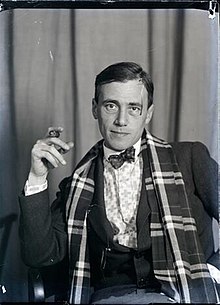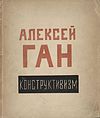Hans Richter (artist)
Hans Richter | |
|---|---|
 Richter c. 1928 | |
| Born | 6 April 1888 Berlin, Germany |
| Died | 1 February 1976 (aged 87) Minusio, Switzerland |
| Occupation(s) | Painter, graphic artist, avant-gardist, film maker, animation producer |
| Years active | 1914–1961 |
| Spouse | Meta Erna Niemeyer (aka Ré Soupault) |
Hans (Johannes Siegfried) Richter (6 April 1888 – 1 February 1976) was a German Dada painter, graphic artist, avant-garde film producer, and art historian. In 1965 he authored the book Dadaism about the history of the Dada movement.[1] [2] He was born in Berlin into a well-to-do family and died in Minusio, near Locarno, Switzerland.[3]
From Expressionism through Dadaism, Constructivism and Neoplasticism, he was one of the major figures of avant-garde art in the 1910s and 1920s[3] and a catalyst for intellectuals and artists in many disciplines. Richter helped organise exhibitions which revived interest in Dada, both in the United States and Europe. In 1956 he made Dadascope, a film dedicated to Dada poetry.
Germany
In 1908 Richter entered the Academy of Fine Art in Berlin, and the following year the Academy of Fine Art in Weimar. Richter's first contacts with
At that time he also befriended Franz Pfemfert, who was the editor of Die Aktion.[4] Richter contributed to the periodical Die Aktion in Berlin.[5] His first exhibition was in Munich in 1916, and Die Aktion published a special edition about him. In the same year he was wounded and discharged from the army and went to Zürich and met Tristan Tzara, Marcel Janco, Jean Arp, and Hugo Ball, who together were forming the Dada movement, which he joined.
Richter believed that the artist's duty was to be politically active by opposing war and supporting revolution. His first abstract art works were made in 1917. In 1918, Tristan Tzara introduced Richter to Viking Eggeling and the two experimented together with film. Richter was co-founder, in 1919, of the Association of Revolutionary Artists (Artistes Radicaux) at Zürich. In the same year he created his first Prélude: an orchestration of a theme developed in eleven drawings. In 1920, he became a member of the November Group in Berlin and contributed to the Dutch periodical De Stijl.
Throughout his career, Richter claimed that his 1921 film, Rhythmus 21, was the first
In 1933,
About Richter's
I conceive of the film as a modern art form particularly interesting to the sense of sight. Painting has its own peculiar problems and specific sensations, and so has the film. But there are also problems in which the dividing line is obliterated, or where the two infringe upon each other. More especially, the cinema can fulfill certain promises made by the ancient arts, in the realization of which painting and film become close neighbors and work together.
United States
Richter moved from Switzerland to the United States in 1940 and became an American citizen. Beginning in 1941 he taught at the Institute of Film Techniques at the
Personal life
Hans Richter was married four times: in 1916 to Elisabeth (Lisa, Lies, Lieska) Steinert († 1923), in 1921 to Maria von Vanselow (divorced 1922), in 1927 to Erna Niemeyer (pseudonyms: Renate Green, Ré Soupault, René Mensch), in 1951 to Frida Ruppel (1910-78), whose two children Hans Ruppel and Ursula Lawder administered the estate.[11]
Filmography
- Rhythmus 21 (1921)
- Rhythmus 23 (1923)
- Rhythmus 25 (1925)
- Filmstudie (1926) with music by Hans Heinz Stuckenschmidt
- Inflation (1927)
- Hindemith) (1928)
- Zweigroschenzauber (1929)
- The Storming of La Sarraz (written only, directed by Sergei Eisenstein, lost) (1929)
- Rennsymphonie (1929)
- Alles dreht sich, alles bewegt sich (1929)
- Everyday (1929)
- Neues Leben (1930)
- Europa Radio (1931)
- Hallo Everybody (1933)
- Keine Zeit für Tränen (1934)
- Vom Blitz zum Fernsenhbild (1936)
- Dreams That Money Can Buy (1947)
- 8 x 8: A Chess Sonata in 8 Movements(1957)
- Dadascope (1961)
- From the Circus to the Moon (1963)
See also
Notes
- ^ Hans Richter, Dadaism, New York: Thames and Hudson, 1965
- ^ "Magazine Features – Hans Richter, Dada Pioneer". Artnet.com. Retrieved 18 August 2014.
- ^ a b Oxford Dictionary of Modern and Contemporary Art, Oxford University, p. 598
- ^ "Hans Richter". Retrieved 19 August 2022.
- ISBN 0-500-20039-4., p. 220
- ^ Article on Futurist Cinema Archived 7 October 2002 at the Wayback Machine
- ^ "'The Futurist Cinema' Manifesto, 1916". Unknown.nu. Retrieved 18 August 2014.
- ^ a b Haftmann, p. 222
- ^ "Historic Films – Calder Foundation". Retrieved 30 May 2017.
- ISBN 0-500-20039-4.
- ^ Biographie, Deutsche. "Richter, Hans - Deutsche Biographie". www.deutsche-biographie.de (in German). Retrieved 25 June 2023.
References
- Stephen C. Foster, Hans Richter: Activism, Modernism, and the Avant-Garde (Cambridge, MA: MIT Press, 1998). OCLC 43718368.
- Mark Purves and Rob McFarland, "Hans Richter: Biography" in: Christoph Bareither et al. (Eds.): Hans Richters "Rhythmus 21": Schlüsselfilm der Moderne.Königshausen und Neumann, Würzburg, 2012. ISBN 382604861X(Article in English).
- Hans Richter, 'Towards a New World Plasticism' in Mary Anne Caws, Manifesto: A Century of Isms (Lincoln, Nebraska and London: University of Nebraska Press, 2001).
Further reading
- Richard Suchenski, "Hans Richter", Senses of Cinema 49 (February 2009).
External links
- "From the Circus to the Moon" (1963) on YouTube
- Hans Richter at IMDb
- Hans Richter films at Ubuweb
- Hans Richter at YouTube
- Finding aid for Arnold Eagle papers and films related to Hans Richter, Getty Research Institute, Los Angeles. Accession No. 970021. This collection documents the film collaborations and friendship of German-born Dadaist, Hans Richter, and New York photographer and cinematographer, Arnold Eagle. It includes color film footage, out-takes and audiotracks for several of Richter's films, such as Dreams that Money Can Buy and 8 x 8 Chess Sonata in 8 movements.

